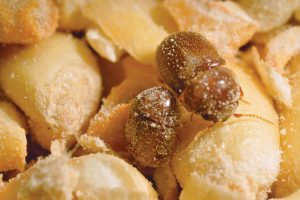Q: A homeowner has a cigarette beetle infestation in her pantry. She buys large quantities of organic food and stores them for months. In one glass container, I found cigarette beetles along with tiny, black, wasp-like insects. In the container is a foodstuff that looks like cornflakes. What are the tiny insects? What recommendations can I make to this customer to prevent these problems?
—FRED H., VERMONT
A: I suspect the tiny insects are one of the parasitic wasps that attack other insects — in this case, the cigarette beetle larvae. The wasps lay their eggs in or on the cigarette beetle larvae. The wasp larvae bore into the cigarette beetle larvae and complete their life cycle. If you eliminate the cigarette beetles, you’ll eliminate the wasps. These wasps are harmless to humans.
I’d recommend that the homeowner microwave the food products she buys when she brings them home. Then they should be stored in sealed plastic or glass containers to prevent infestation. Microwaving will kill all stages of stored product insects.
Q: From time to time, a homeowner will give me a piece of clothing and ask whether the holes in it were caused by moths. How do you tell insect damage from other damage? What else can cause damage to clothes? If it is insect damage, what should I do to stop it?
— RICHARD H., NEW YORK
A: The first thing I’d look for is a label. If the clothing has no wool in it, the damage probably is not due to insects. If there is no label or if the clothing contains wool, look around the edges of the damage for webbing, silverfish scales or carpet beetle frass or hairs. These are the insects usually associated with wool damage.
If you can’t find evidence of insects, look at the location of the damage. If it is on sleeve cuffs, the “tail” of a shirt or sweater, elbows or other wear areas, the damage is probably mechanical from normal wear and tear (some people refuse to accept that clothes wear out). If the wool fibers are curled up on the ends of the hole, it could be chemical damage caused by bleach or other caustic substances.
If the damage is caused by insects, have the clothing and other wool products stored in the same area dry-cleaned. This will kill all stages of insect development. If there’s evidence of silverfish or carpet beetles, try a crack-and-crevice treatment. Clothes moth larvae remain on clothing, so an area treatment is unnecessary. A little aerosol will knock down any flying moths.
Q: We frequently have palmetto bugs (American cockroaches, Periplaneta americana) show up inside customers’ houses even though we have done a thorough job of treating the exterior of the building. The individual insects are usually dead; only an occasional live one shows up at any one time. Is there anything we can do to prevent such occurrences? Even though the cockroaches are dead, their presence doesn’t help customer relations.
— GARY C., FLORIDA
A: This is a common problem. There must be one or more entry points the cockroaches enter from outdoors. Most often, it’s the door seal at the bottom of the door. They wear over time. If you can slide a credit card under any door, have the seals replaced.
Email your questions about insect identification and pest management technologies and techniques to Dr. Doug Mampe, an industry consultant, at dentomol@aol.com. They will most likely will be printed and answered in one of Pest Management Professional’s upcoming Ask the Expert columns.

Leave A Comment